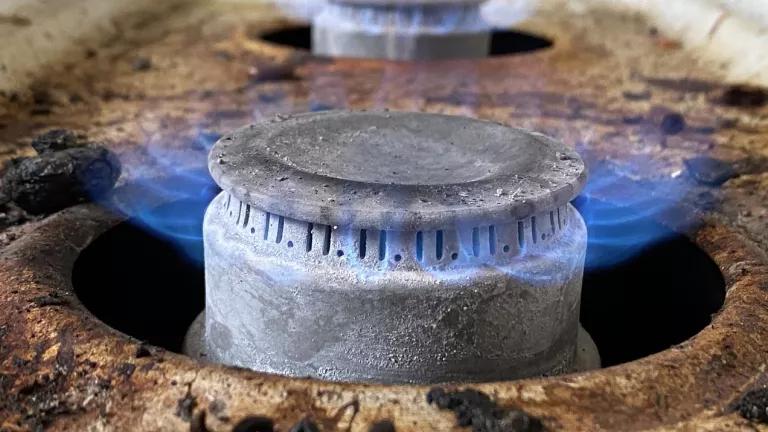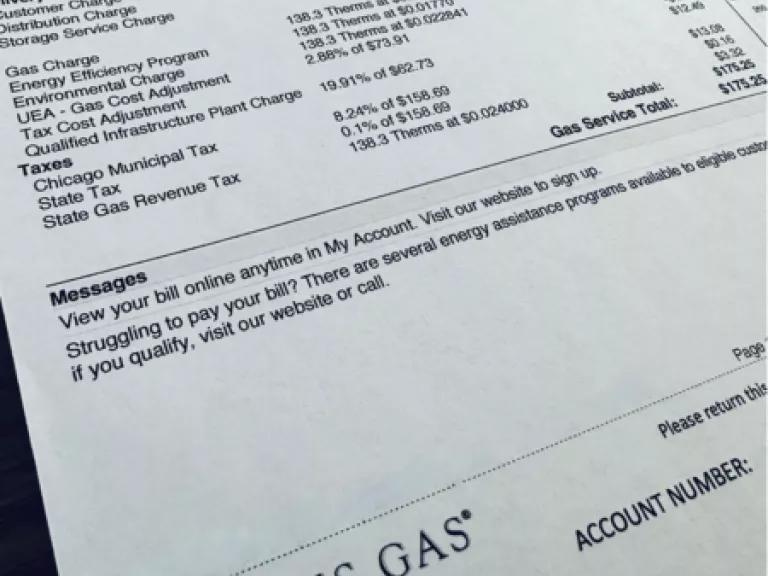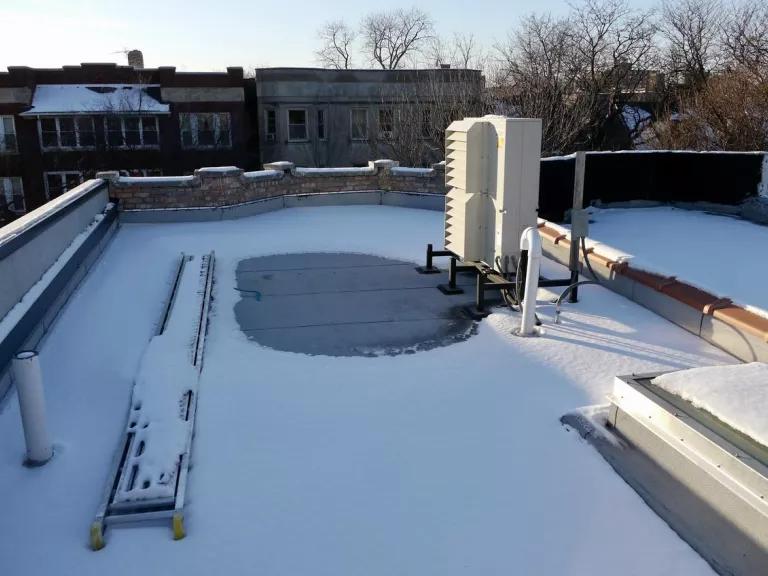"Natural" Gas Is Expensive and Dangerous. We Can Do Better.
Large gas utilities in Illinois are pushing for a historically large rate increase. Now is the time to make the switch to cleaner home appliances.

Gas appliances are linked to high concentrations of health-harming pollutants in homes.
Jason Woodhead
If you live in Illinois and you pay a gas bill, you’ve likely seen that bill go up in recent months—probably by a lot. That bill may get even more expensive soon because the state’s largest gas utilities are pushing for a historically large rate increase.
What many of us may not already know is that so-called “natural” gas is mostly made up of a fossil fuel: methane gas. When gas is burned in our homes, it does serious harm to our health and our climate.
The good news: Modern, all-electric heating and cooking appliances can provide dependable, clean, and affordable heat for our homes without relying on fossil fuels like gas.
Before we get to the benefits of those cleaner appliances, it’s worth exploring how gas bills got so high, and how gas harms people and the climate.
Gas bills in Illinois are high and set to get higher
Two things go into the rising cost of our gas bills: one, the cost of gas as a commodity, and two, the cost of all the infrastructure required to get gas to your house (for example, pipes, pumps, and compressors).
The price of gas as a commodity over the last 12 months is the highest it's been since at least 2014, according to data from the Illinois Commerce Commission. While gas commodity prices are down slightly from their record highs last year, analysts are advising that we “fasten our seat belts” because the “volatility [of gas prices] could get even higher in the coming years.”

J.C. Kibbey
While the price of gas as a commodity has been around the world, gas infrastructure prices are especially high in Illinois specifically. This is due in large part to massive spending by the gas utilities—paid by customers—to replace and expand gas delivery systems. Every dollar of that spending earns the utilities a profit.
Gas utilities have claimed the spending was necessary to “ensure safety” by “replacing aging cast-iron pipes.” But gas utilities have been overhauling their entire systems rather than targeting unsafe pipes. Peoples Gas, which serves Chicago, is “using the extra money it gets to upgrade its entire system, rather than the pipes most at risk.” Peoples Gas system overhauls are also projected to run more than $9 billion over budget. Nicor Gas, which serves most of northern Illinois outside Chicago, replaced all its cast-iron pipes years ago. As did Ameren Gas, which serves central and southern Illinois. But both companies have continued to spend hundreds of millions of dollars on system overhauls that allow them to “deliver more gas,” in Ameren Gas’ own words.
Gas utilities are expanding the gas system to grow their business and profits under the guise of safety.
Peoples Gas has among the highest fixed charges in the country. Customers pay the company a $34 “customer charge” before they use a single bit of gas, and on top of that, the average customer pays more than $16 a month for the “qualified infrastructure plant” charge. Other gas utilities in the state have hiked rates in recent years, too: Ameren has raised its delivery rates by 27 percent, and Nicor Gas by 77 percent. Even if gas commodity prices stabilize, the high rates and charges from gas utilities will continue to keep gas bills high in Illinois.
Skyrocketing gas bills have left many people in Illinois unable to afford them. Nearly one in five customers in Chicago is behind on their gas bill, even as gas utilities collect tens of millions of dollars in late fees and notch record profits. The impact of higher energy bills is highly racially inequitable: Black people and Latinos are significantly more likely to be unable to pay an energy bill, and more than twice as likely to experience disconnection, compared to white people; people with children under five are also far more likely to be unable to pay a bill or be disconnected. Illinoisans are literally being left out in the cold: Illinois is no. 1 in the nation for gas shut offs, with gas utilities shutting off service to more than 82,000 customers last year.
Yet gas utilities are seeking to raise prices even more. Last month, nearly all the state’s gas utilities filed for rate hikes: Peoples Gas wants to raise rates on its customers by more than $400 million. Nicor Gas is seeking a $321 million rate hike. Ameren has proposed raising rates for its gas customers by more than $160 million. All in all, Illinois gas utilities are trying to raise rates by more than $900 million.
As gas utilities are seeking to massively expand and entrench the gas system, science is showing us that the health and climate harms of gas are worse than previously thought.
Gas harms people's health, especially children and people of color
Like all fossil fuels, gas generates pollutants harmful to human health when it’s burned, including nitrogen oxides (NOx), fine particulate matter (PM), and carbon monoxide (CO).
Multiple studies have found that gas appliances are associated with high concentrations of these pollutants in homes—often higher than what the U.S. Environmental Protection Agency considers safe for outdoor air. Unsurprisingly, a growing body of research has found that gas-burning appliances in our homes harm human health, especially for children.
More than one in five (21 percent) childhood asthma cases in Illinois is attributable to gas stove use – the highest of any state in the nation (the national average is about 13 percent). Children living in a home with gas cooking have a 42 percent increased risk of asthma, according to another peer-reviewed study.

National Institutes of Health
Scientists also found that gas appliances in the home are associated with diminished cognitive function in children, as well as symptoms of attention-deficit hyperactivity disorder (ADHD).
One of the most dangerous forms of pollution that gas-burning appliances generate is fine particulate pollution (PM2.5). It causes an estimated 52,000 deaths in the U.S. each year, it is deadly even at very low levels, and it is associated with cardiovascular disease, kidney disease, chronic obstructive pulmonary disease (COPD), dementia, type 2 diabetes, hypertension, lung cancer, pneumonia, and premature death.
Like many forms of pollution, the harms of this deadly pollutant are not distributed evenly. Public awareness has grown in recent years about the racially inequitable exposure to pollution from fossil fuel-fired power plants. This is true for pollution from gas-burning stoves, even more so: When it comes to deadly fine particulates, residential gas combustion is the single most racially inequitable form of pollution exposure, with people of color exposed to 41 percent more than white people.
People of color are also far more likely to live in areas that will experience the worst impacts of climate change—which is also fueled in large part by burning gas.
Gas is a leading cause of climate change
Fossil fuels burned in buildings are one of the largest drivers of climate change, making up 22 percent of climate-warming carbon dioxide pollution in Illinois. Building emissions are the third-largest contributor to climate change in the state, after transportation and power generation, and those emissions come overwhelmingly from gas.
But the real climate impact of gas is even worse than that. Remember, the “natural” gas burned in our homes is mostly methane, an extremely potent greenhouse gas. It warms the planet up to 80 times more than carbon dioxide, pound-for-pound. Methane leaks at nearly every stage of the gas supply chain, from extraction to the big pipelines that transport gas across the country to the distribution pipes in cities to leaks from appliances in people’s homes. The climate impacts of these methane gas leaks are above and beyond the carbon pollution from burning gas.
Scientists agree nearly unanimously that avoiding the worst impacts of climate change will require roughly halving emissions of planet-warming greenhouse gases by 2030, and reducing those emissions to net zero by 2050. That includes buildings.
The Net Zero America project at Princeton University analyzed several different scenarios for achieving net zero emissions by 2050. All of those scenarios found that a huge shift towards efficient electric appliances for water heating, space heating, and cooking is necessary to hit our climate goals—using electricity for at least 80-90 percent of these end uses on the low end, nationally, and nearly 100 percent on the high end.
Put simply: Avoiding catastrophic climate change will require eliminating gas almost completely from buildings.
We have cleaner, more affordable options than gas
Let’s recap: Gas is expensive, it harms our health, and is a main driver of catastrophic climate change.
For a long time, the only real alternative to fossil fuel heating was electric resistance (which can be used for cooking or heating)—this technology had its fans and its critics. But the times—and technology—have changed. A lot. Today’s efficient electric heating technologies are not only cleaner than gas, they’re more affordable and more convenient.
Heat pumps are basically air conditioners that work in both directions—to heat and cool. In the winter, they take heat from the outside and move it inside your house to keep you warm; and in the summer, they take heat from the inside and move it to the outside to keep you cool (if you're wondering how heat pumps draw heat from the outside in the winter, here’s a more detailed explanation of how they work).
Modern "cold climate" heat pumps work even at subzero temperatures—they’re increasingly popular in Maine, Canada, and even frigid Norway. “It got 21 below last winter,” said one Maine resident, “I was a little worried about the heat pumps, but they held out. They kept us warm.”

Steven Vance
Induction stoves use electromagnetic fields to directly heat the pots and pans we cook our food in. This makes them faster, more precise, and much more efficient than gas-burning stoves. “You might be amazed at how well induction works,” said one reviewer, “I started cooking on induction several years ago, and since then, I've never wanted anything else.” Consumer Reports raved that “induction cooktops come as close to perfection as any appliance [they] test.”
On top of being convenient, comfortable, and effective, these appliances cut down on your home’s pollution and your energy bills.
A program in New York helped families living in public housing swap out their gas stoves, and found that in homes with induction cooking, nitrogen dioxide pollution in the home dropped 35% and carbon monoxide levels dropped 43 percent. Electric stoves also cut fine particulate pollution roughly in half, compared to gas stoves.
The climate benefits of switching to efficient, electric appliances are also large. A study by Energy Futures Group found that in Chicago, switching to an all-electric home and away from gas reduces climate-warming greenhouse gas pollution by more than 50 percent—whether in a single-family or multi-family home. Those benefits may be even greater than that, accounting for the large amount of methane that many gas stoves leak, even when they’re turned off.
Ditching gas (and the skyrocketing bills that come with it) and going all-electric can also save people a lot of money. On the low end, going all-electric would save a person or family in Chicago nearly $11,000 over 20 years—even without any rebates or incentives.
New incentives passed as part of the federal Inflation Reduction Act make those economics even better. People with qualified incomes can receive up to $14,000 to buy and install a heat pump and induction stove, and to make electrical and efficiency upgrades to their homes. A person who takes advantage of these rebates would save nearly $25,000 over 20 years.
These federal rebates—specifically targeted at people with low incomes—are key to ensuring equitable access to the benefits of clean, electric heat. While the money for these rebates comes from the federal government, the state of Illinois is tasked with implementing and distributing them. It’s important we get that implementation right so that everyone can enjoy the benefits of clean, efficient, all-electric homes.
There is much more the state of Illinois can do to help its residents move away from dirty, expensive gas and toward clean, efficient, affordable electric heat.
The transition away from gas should start now
The first step to solving a problem is admitting you have one. The evidence is clear: Gas is expensive and getting more so; it’s making people sick, especially people of color and children; and it’s one of the largest contributors to climate change.
In 2023, we have clean, affordable, all-electric technologies to keep us comfortable and well-fed. The federal government has invested extensively to make these technologies even more affordable, and support equitable access to them.
Once upon a time, we burned whale oil for light, we heated our homes with coal stoves, and it seemed normal. Gas may soon join them in the history books. With our wallets, health, and climate on the line, it can’t come soon enough.



